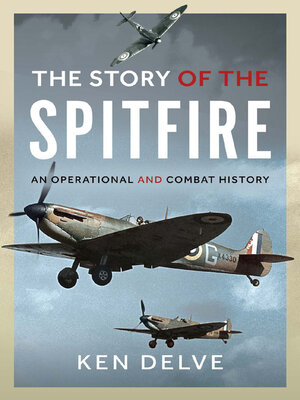
Sign up to save your library
With an OverDrive account, you can save your favorite libraries for at-a-glance information about availability. Find out more about OverDrive accounts.
Find this title in Libby, the library reading app by OverDrive.



Search for a digital library with this title
Title found at these libraries:
| Library Name | Distance |
|---|---|
| Loading... |
An in-depth exploration of the Spitfire's combat legacy, pilot tactics, and its enduring iconic status.
To many people the Supermarine Spitfire was Britain’s saviour during the Battle of Britain and the embodiment of air combat during the Second World War. The Story of the Spitfire presents a thrilling appraisal of this unique aircraft, focusing on its fighting capability and the tactics of the pilots who flew it. Using official evaluations and reports, alongside technical and tactical developments, plus the recollections of Spitfire pilots, Ken Delve provides a fascinating insight into the combat career of this legendary aircraft.
Despite some problems with their new aircraft, the Fighter Command pilots of 1938 were generally delighted with the Spitfire – speed, manoeuvrability and firepower were all far greater than they had been with the earlier biplanes. In tactics and training the RAF was outdated, but it adapted quickly and the air battles over Britain in late 1940 forged the Spitfire legend. How justified was the legend? There were only nineteen Spitfire squadrons in Fighter Command during the Battle of Britain; it was only later, as the RAF turned to the offensive, that the number of Spitfire units increased dramatically.
At certain times the combat initiative was lost to improved Messerschmitt Bf 109s and Focke-Wulf Fw 190s, but with increased performance and better training, the Spitfire clawed back the advantage. By 1944 the Spitfire was operating as a fighter-bomber in various theatres of war, with new tactics and new problems. Many fighter pilots thought that having bombs strapped under the aircraft verged on an insult – but with aerial targets in short supply, this was the most effective, if risky, way of taking the war to the enemy.
After the war the Spitfire saw action right up to 1948 in the Arab-Israeli War. Today there are approximately seventy airworthy Spitfires in existence and R.J. Mitchell’s remarkable aircraft is still the highlight of flying displays around the world.
To many people the Supermarine Spitfire was Britain’s saviour during the Battle of Britain and the embodiment of air combat during the Second World War. The Story of the Spitfire presents a thrilling appraisal of this unique aircraft, focusing on its fighting capability and the tactics of the pilots who flew it. Using official evaluations and reports, alongside technical and tactical developments, plus the recollections of Spitfire pilots, Ken Delve provides a fascinating insight into the combat career of this legendary aircraft.
Despite some problems with their new aircraft, the Fighter Command pilots of 1938 were generally delighted with the Spitfire – speed, manoeuvrability and firepower were all far greater than they had been with the earlier biplanes. In tactics and training the RAF was outdated, but it adapted quickly and the air battles over Britain in late 1940 forged the Spitfire legend. How justified was the legend? There were only nineteen Spitfire squadrons in Fighter Command during the Battle of Britain; it was only later, as the RAF turned to the offensive, that the number of Spitfire units increased dramatically.
At certain times the combat initiative was lost to improved Messerschmitt Bf 109s and Focke-Wulf Fw 190s, but with increased performance and better training, the Spitfire clawed back the advantage. By 1944 the Spitfire was operating as a fighter-bomber in various theatres of war, with new tactics and new problems. Many fighter pilots thought that having bombs strapped under the aircraft verged on an insult – but with aerial targets in short supply, this was the most effective, if risky, way of taking the war to the enemy.
After the war the Spitfire saw action right up to 1948 in the Arab-Israeli War. Today there are approximately seventy airworthy Spitfires in existence and R.J. Mitchell’s remarkable aircraft is still the highlight of flying displays around the world.







